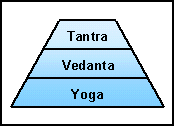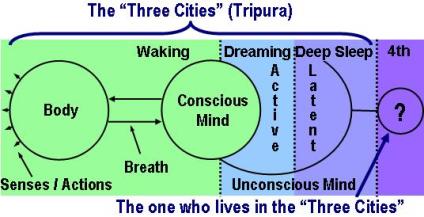|
Home Site Map CDs Tradition 6 Schools Dualism & non-dualism Kundalini |
||||||||||||||||||||||||
|
|
The Three Streams of
Brief descriptions: While these philosophies and practices are vast, the following brief descriptions will give an idea of the nature of each, and how they work together. Then, these can be expanded upon through further studies and practice. See also
these articles:
1st Stream: Yoga Yoga, as described by Patanjali, is preparation or foundation practice, and is codified (arranged or systematized) in the four chapters of the Yoga Sutras. The word codified is commonly used because the Yoga science was recorded by Patanjali over 2000 years ago, although the science itself was not new, having been known for thousands of years before that time. Patanjali codified Yoga into 196 sutras (literally threads) outlining the path of Yoga (Sometimes divided into 194, 195, 196, or 197 sutras). Yoga deals head-on with the obstacle of the mind and how to purify that mind so that it is an aid on the inner journey. It presumes that the seeker has done the preparatory work to be able to do these practices. Yoga science rests on the twin principles of cultivating practices (Abhyasa) that bring stable tranquility and non-attachment (Vairagya) (Yoga Sutras 1.12-1.16). Yoga focuses on discriminating, in meditation, between consciousness (Purusha) and matter (Prakriti) at all of it's levels (Yoga Sutras 3.4-3.6). In that way, one comes to know the pure consciousness in it's own being (Yoga Sutras 1.3, 3.56). Yoga is also known as Raja Yoga, or the Royal Yoga, in that it encompasses the other Yogas. It is also known as Ashtanga Yoga, referring to the eight rungs or limbs described in the Yoga Sutras. Ashta means eight; Anga means limbs or rungs. (It is important to note that the phrase Ashtanga Yoga has recently become known as a system of physical postures, which was never the ancient intent of this name).
2nd Stream: Vedanta Vedanta provides a contemplative means of self-enquiry and exploration. Vedanta is expressed in the Upanishads, estimated to have been written in the period from the fifth to tenth centuries BCE, although the principles had been taught orally for a very long period prior to that; some say by thousands of years more. The contemplative style of Vedanta meditation suggested by the Himalayan sages is compatible with the meditation of the Yoga Sutras. The self-enquiry is coupled with the inner reflection on contemplative statements called Mahavakyas, as well as reflection on, and witnessing of the Four functions of mind and exploring the three states of waking, dreaming and deep sleep so as to experience the consciousness that permeates all of those three levels, and which is symbolized by the Om Mantra. Of particular importance is the introspection of the waking, dreaming, and deep sleep levels of consciousness, which have as their counterparts the gross, subtle, and causal planes of reality. It means examining not only the conscious, but also the unconscious and subconscious levels of mind, so that these can ultimately be transcended. These levels are most succinctly summarized in the Mandukya Upanishad, which deals with the levels of the meaning of the OM Mantra. Vedanta is expressed in the Upanishads, estimated to have been written in the period from the fifth to tenth centuries BCE, although the principles had been taught orally for a very long period prior to that; some say by thousands of years more. To be able to successfully do the inner explorations and contemplations, it is necessary that the mind has been reasonably purified or stabilized. Then the fruits of the self-enquiry will come. Otherwise, the practices can merely lead to anxiety.
3rd Stream: Tantra Tantra deals with the energy systems of our being, going directly to the heart of consciousness. It emphasizes the creative aspect of consciousness (shakti), and following that creative aspect back to it's source. That consciousness is known as Tripura, the one who lives in the three cities of waking, dreaming and deep sleep (tri means three; pura means city).
There are three schools of Tantra, of which the deepest, or subtlest is Samaya, a purely internal form of Tantra Yoga whose sole goal is spiritual liberation or enlightenment. It deals with the higher energy centers, up to the energy center at the top of the head, the crown chakra. In the tradition of the Himalayan masters, it is this higher Tantra Yoga that is emphasized, and it rests of the solid foundation of the practices of purifying and self-reflection of Yoga and Vedanta.
In search of the source For a very long time, many people, from many countries, from all of the major religions have traveled to the Himalayas in search of the wisdom and methods of the ancient sages. Occasionally, that wisdom or some part of it is found, assimilated, repackaged under a new name, and presented to the people of the world, of a particular culture, or from within a particular religious context. However, when one asks what is the source of that perennial wisdom, or more accurately, how can one gain a foothold into that wisdom and practice, where does one turn? What system, philosophy, or texts might one study that captures the core teachings of those ancient sages of the Himalayas? And, more importantly, what methods might one practice? It is out of that perennial fountain that these schools of Yoga, Vedanta, and Tantra practice have sprung. It is not a matter of the ancient wisdom being a composite of Yoga, Vedanta, and Tantra, like some cut-and-paste job. Rather, the tradition of the Himalayan sages is the source out of which these three, and others have emerged. They are the outpouring of that original fountain. If we want to find our way back to the original fountain, to be guided by that source, one of the ways to do so is by studying and practicing those three (Yoga, Vedanta, and Tantra), while remembering the existence and centrality of the original fountain. Even the Himalayan sages of today do not just practice one or the other of Yoga, Vedanta, and Tantra. Rather, they are fully integrated into a whole, much like three major strands of a sturdy rope work together. To study and practice this way is the way of the Himalayan tradition.
-------
|
|
||||||||||||||||||||||


